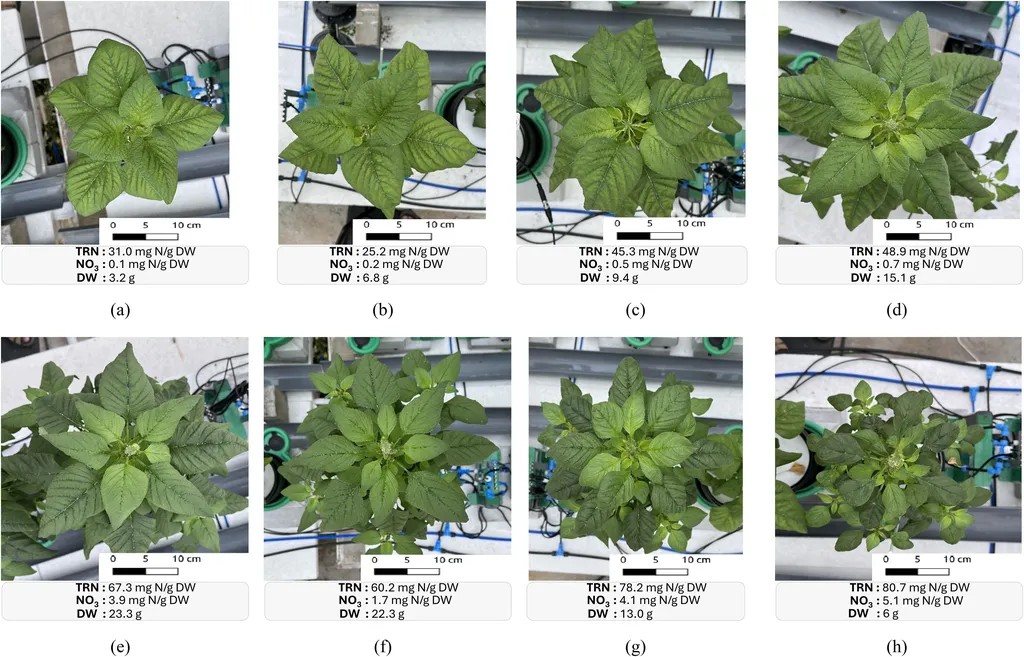In the ever-evolving world of precision agriculture, a groundbreaking study led by Yohanes Bayu Suharto from Politeknik Pembangunan Pertanian Bogor has shed light on a non-destructive, efficient method for monitoring nutrient stress in leafy vegetables. Published in the *Journal of Tropical Agricultural Engineering and Biosystems* (Jurnal Keteknikan Pertanian Tropis dan Biosistem), the research explores the correlation between RGB image-based vegetation indices and chlorophyll content, offering promising implications for the agricultural sector.
Nutrient stress is a critical factor affecting the growth and productivity of leafy vegetables. Traditional methods of measuring chlorophyll content, an indicator of plant nutrient status, are often destructive and inefficient. Suharto’s study aims to change this by analyzing the correlation between various vegetation indices derived from RGB images and chlorophyll content in hydroponically cultivated leafy vegetables under nutrient-stress conditions.
The study utilized six vegetation indices: Excess Green (EXG), Visible-band Difference Vegetation Index (VDVI), RGB Vegetation Index (RGBVI), Normalized Green Blue Difference Index (NGBDI), Green-Red Vegetation Index (GRVI), and Visible Atmospherically Resistant Index (VARI). RGB image data were captured using a standard digital web camera sensor under controlled lighting conditions, while chlorophyll content was measured using a SPAD-502 Chlorophyll Meter.
The results were striking. Pearson correlation analysis revealed that the vegetation indices VARI and GRVI had robust correlations with chlorophyll content, with correlation coefficients of 0.90 and 0.89, respectively. “These findings indicate that VARI and GRVI can be highly effective for estimating chlorophyll content in leafy vegetables,” Suharto explained. “This method is not only non-destructive but also efficient, making it a valuable tool for precision agriculture.”
The implications of this research are far-reaching. By providing a non-destructive method for detecting nutrient stress, farmers and agritech companies can optimize nutrient management, improve crop yields, and reduce waste. “This technology has the potential to revolutionize the way we monitor plant health,” Suharto added. “It can be integrated into automated monitoring systems in greenhouses and precision agriculture platforms, offering real-time data to farmers.”
The study’s findings are particularly relevant for the commercial sector, where efficiency and accuracy are paramount. By adopting RGB image-based vegetation indices, companies can enhance their monitoring capabilities, leading to better resource management and increased productivity. “The integration of this technology into existing systems can significantly improve the accuracy and efficiency of nutrient stress detection,” Suharto noted. “This can lead to more sustainable and profitable agricultural practices.”
As the agricultural industry continues to embrace technological advancements, Suharto’s research offers a glimpse into the future of precision agriculture. By leveraging the power of RGB imaging and vegetation indices, farmers and agritech companies can stay ahead of the curve, ensuring optimal plant health and maximizing yields. The study’s publication in the *Journal of Tropical Agricultural Engineering and Biosystems* underscores its significance and potential impact on the field.
In conclusion, Suharto’s research represents a significant step forward in the realm of precision agriculture. By providing a non-destructive, efficient method for monitoring nutrient stress, this study opens up new possibilities for optimizing plant health and improving agricultural practices. As the industry continues to evolve, the integration of RGB image-based vegetation indices is poised to play a crucial role in shaping the future of farming.

